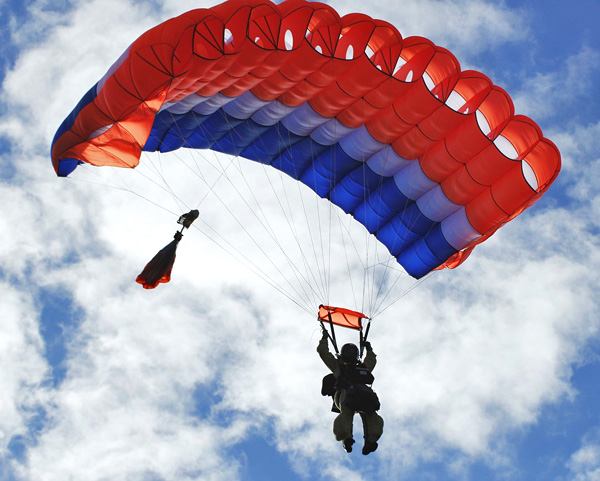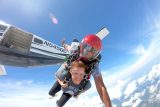What are the Different Types of Skydiving?
General
Posted by: Long Island Skydiving Center
3 years ago
You’ve see it on movies, television, and maybe even heard of somebody actually going skydiving before! But did you know that there are different types of skydiving?
Yup! There are multiple skydiving disciplines and all kinds of skydivers – tandems, students, freeflyers, belly flyers, angle flyers, canopy pilots, and those who skydive as a career (talk about dream job). In fact, you could do ALL of these skydiving disciplines within your skydiving career.
With all of the different options out there for skydiving it can seem a bit confusing, so we’re here to break down ALL of the different types of skydiving into eight categories.
DIFFERENT TYPES OF SKYDIVING
TANDEM SKYDIVING
Tandem skydiving is the most popular choice for first time skydivers

Tandem skydiving requires no prior experience and allows almost anybody to skydive! On a tandem skydive, the tandem student is attached to an experienced, professional tandem skydiving instructor. The instructor’s job is to operate all of the skydiving equipment and ensure the student has an awesome experience!
Tandem skydiving is the best way to experience skydiving without the responsibility of having to operate your own parachute or go through all of the training necessary in order to skydive solo. You’ll have the opportunity to enjoy every moment of the skydive and be fully present in this incredible experience.
AFF SKYDIVING
AFF (Accelerated Freefall) is the program that student skydivers go through in order to learn how to skydive on their own.
In the AFF program, you’ll attend a ground course and perform a series of supervised and self-supervised jumps. The program varies depending on which dropzone you decide to get your skydiving license through, but the United States Parachute Association (USPA) requires that 25 jumps must be completed and the student must be able to pass a written exam before receiving their USPA A license.
The A license grants you the freedom to jump completely on your own or with others and allows you to progress within the sport and try out different skydiving disciplines. Each skydiving discipline usually has its own requirement to meet before attempting them.
FORMATION SKYDIVING

Formation skydiving (FS) is referred to as “belly flying” and is probably the most popular type of skydiving among licensed skydivers.
Formation skydiving is where skydivers will hold onto one another to form different shapes in the sky. This discipline is usually the next step people go to after getting their skydiving A license.
Formation skydiving is a popular skydiving discipline within the skydiving competition world. Yep, you heard that right! Skydivers can compete at the National and World levels – and they do! (And actually, the USA is very good at this – earning multiple World Championship titles). FS competitions are done in groups of 4-way, 8-way, or 16-way along with a videographer to record the jumps for precise scoring.
FREEFLYING
Freeflying is an advanced skydiving discipline where skydivers will fly their bodies in all orientations – not just belly-to-Earth.
Freeflying can be either dynamic (moving your body in multiple positions), or static (staying in one place). These flyers can fly in head up, head down, back, and seated (sit fly) positions.
You can also compete in this type of skydiving and it can be broken down into two different categories: VFS (vertical formation skydiving) and freestyle. VFS is similar to FS but in more advanced body positions. Freestyle is where skydivers get creative and make up their own routines and compulsories in order to score points.
ANGLE FLYING
Angle flying is a popular skydiving discipline in which skydivers fly their bodies at an angle – either on their back or belly – in order to shoot through the sky like a rocket with other skydivers!
This discipline is especially popular with freeflyers and others who are interested in a lot of movement in the sky. They can reach pretty high speeds which is why this is only recommended for quite experienced skydivers.
WINGSUITING
Wingsuiting is a form of skydiving that is practiced when wearing a wingsuit, sometimes referred to as a “squirrel suit.” You’ve probably seen this one before.
The wingsuit allows you to glide through the sky like a bird, or a flying squirrel. The skydiver controls the suit in order to change their descent rate and direction, making their flying journey last a bit longer in the air since they can travel in a horizontal direction.
There are even wingsuit competitions at the National and World level! There are two disciplines within the wingsuit world: wingsuit acrobatic and wingsuit performance.
CANOPY PILOTING
Canopy piloting focuses solely on parachute flying skills.

There are three disciplines within canopy piloting: CRW, swooping, and accuracy.
CRW (pronounced “crew”) stands for “canopy relative work” and is done with other canopy pilots. This is where parachutists will link or “dock” onto each other’s canopies by hooking their feet. CRW can be done in pairs, fours or even more – building beautiful eye-catching formations in the sky. This discipline requires great skill and experience.
Swooping is the skydiving discipline of accelerating the descent rate of the parachute by initiating turns and increasing the forward speed as they approach the ground. This is an extremely advanced skill that should only be performed by skydivers who have been instructed in this discipline.
Accuracy landing is where the jumpers will try to land their parachutes on the center of a target that is only 2 centimeters in diameter.
WORK JUMPS
Work jumps are performed by skydivers who jump for a living!
Tandem Instructors are those spunky, twinkle-in-their-eye skydivers who take you on the adventure of a lifetime. They go through strict requirements that must remain current in order to perform tandem skydives at USPA-rated dropzones.
Videographers are skydivers who strap cameras to their helmets to capture your experience! Videographers are also seen in the competition world as they are the ones responsible for capturing the skydive for the judges to review and score. They are treated as part of the team because it requires a certain set of unique skills to capture the skydive perfectly.
Coaches and AFFI or “Accelerated Freefall Instructors” are the ones who teach students how to skydive. They also go through rigorous training and credentialing that must stay current.
Organizers are usually seen at special skydiving events. They lead the jump and teach people how to hone their skydiving skills.
Demonstration (or Demo) jumps are jumps that you usually see at special events like football games. These skydivers will jump into the stadium or special event to “wow” the crowd. Sometimes these jumpers will wear specific flags in order to represent a movement or country (like flying an American flag).
Military jumps are performed only by military personnel who need to train for air-based operations.
Do any of these types of skydiving intrigue you? Get started on your skydiver journey and book your tandem jump with NYC’s closest skydiving center – Long Island Skydiving Center! Blue skies.
Categories:
You May Be Interested In:

Is A Skydiving Proposal A Good Idea?
9 months ago by Long Island Skydiving Center

Skydiving For Couples: Fun Date Activity In NYC
9 months ago by Long Island Skydiving Center

Where Can I Go Skydiving in New York?
11 months ago by Long Island Skydiving Center

What Is A Skydiving Landing Like?
11 months ago by Long Island Skydiving Center